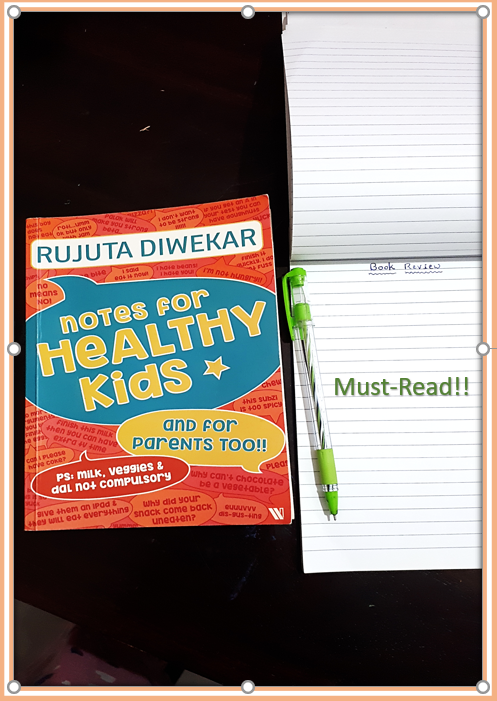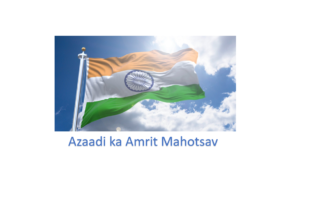India’s most followed Nutritionist Rujuta Diwekar’s one of the important (much needed) books , “Notes for Healthy Kids” is an excellent read for all those, who wants to see their next generation in the pink of health!!
She bursts popular food myths and enlightens her readers about how going back to tradition helps in fortifying our health and contributes to overall wellbeing of the earth. What makes it more compelling for me is, the book talks about simple known things, yet gives new insights and perspective!
More than a review, this article is an attempt to collate the key points of the book, because the wisdom imparted is priceless! The more awareness, the better for future generation!

The Book is divided into 2 parts and an Epilogue, which beautifully concludes how the three stakeholders “Parents, Schools and Policymakers” should work together to ensure healthy environment for our next generation. Not to forget the “Appendix” which gives quick notes about “What, When and How” to eat the food.
Part 1 : Knowledge about Food and Exercise. This again is subdivided into chapters, each for parents and for kids.
Key Takeaways for parents:
- Do not fall for Nutritionism (looking at food from the point of view of nutrients is called Nutritionism), instead eat local, seasonal and traditional food.
- Focus should be to inculcate right eating habits by involving the children in the process of making the food.
- Follows 3 S’s of eating right : Sit (on the floor with legs crossed while eating), Switch Off (all the gadgets), Senses (eat with your senses).
- Finish dinner by 8pm with a simple meal.
- “Milk for Calcium, Veggies for Vitamins, Dal for Protein” is a myth. Fact is there are plenty of other (local and traditional food) options which provide the body with same nutrients. So you don’t have to pressurise your kids to eat only these.
- Exercise is most important aspect of raising a healthy child, so make it non-negotiable part of your/child’s routine.
- Encourage kids to play for the sake of the game not to raise future sports person!
- Don’t stop kids from playing because of weather conditions.
- Once in a while take the kids on holidays where more of physical activities are involved (ex: cycling, hiking, skiing ,etc) and gadgets are ditched.
Key Takeaways for Kids :
How to identify the right food? – Check if it passes the below 3 tests.
- Grandma should identify it and should have eaten when she was of your age.
- Does the food have a local name
- Can it be used in multiple ways (versatility) (For Ex: Banana is cooked into a sabzi in raw form, eaten as fruit, used in dessert,etc.)
How to identify the unhealthy food – if it falls in any of the below categories.
- Does it come in a packet?
- Does it claim to provide nutrient benefits to your body?
- Any free toy, foreign trip option is given for buying the product?
- Any of your favorite celebrity is endorsing the product?
Along with eating right, kids should also give enough exercise to their body and mind
- Learn any balancing movement. Ex – cycling, skating, skiing ,etc
- Learn Yogasanas (bodily movement), short prayer is okay but not hours of sitting and doing meditation and pranayama.
- Choose play over studies any day!!! (Kids will love you for this Rujuta)
- Ninety minutes of free play everyday (outside, board games doesn’t fall in this category)
- Learn any form of dance or classical instrument.
Part 2: How to apply the knowledge gained in part1 in day to day life. This section is aptly categorized into ‘Age-Wise’, ‘Occasion-Wise’, ‘Health issues’ and ‘Frequent illness’ which really makes it easy for a quick reference.
She reminds the reader about the local food options/practises and explains how one can adapt to it easily by making simple lifestyle changes.
The writer also throws light on NCDs (non communicable diseases) and some of the childhood health issues which are manifested by modern lifestyles.
Book is all about serious topics like health and food. But, writer makes it interesting by elaborating real life incidents in a humorous way, while connecting the knowledge of food with it.
So, even if you are not a regular reader, I still recommend this book, it is worth a try!!
P.S. If you are already enlightened by this book (or any other Rujuta Book), please let me know your thoughts in the comments section 🙂


